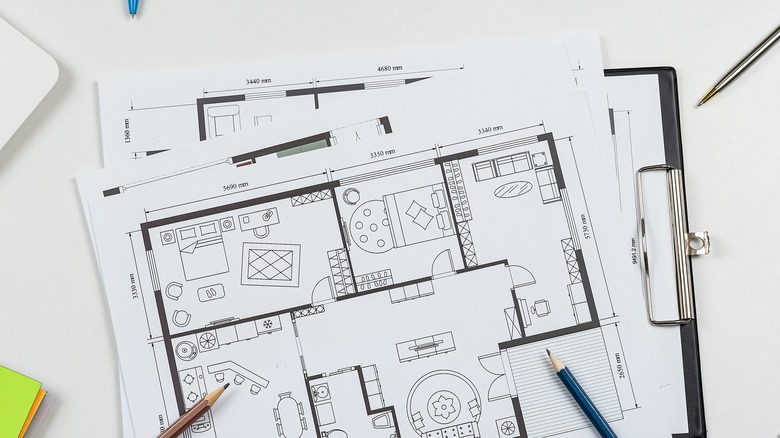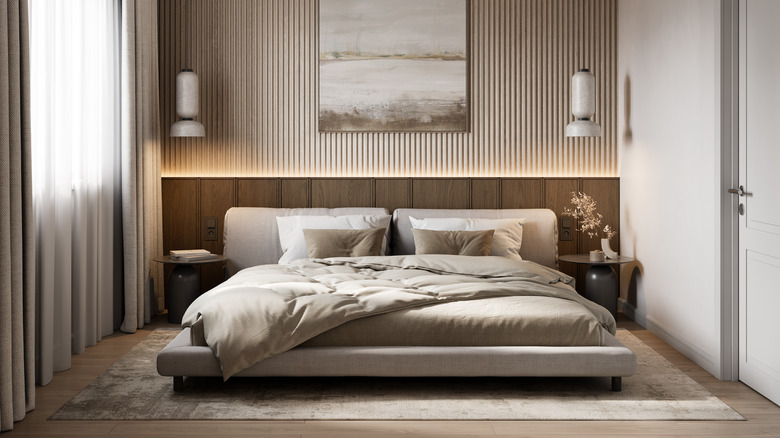Tips For Arranging A Large Bed In A Small Room
There's nothing better than flopping down on a big, comfortable bed at night, ready for a good night's sleep with plenty of elbow and leg room. In fact, many people feel that the bigger the bed, the better — some even opting for oversized beds larger than king size for maximum sleep space. However, what happens when you only have a small bedroom space to work with?
The great news is that even small bedroom spaces can typically accommodate larger bed sizes such as a queen, king, or California king ... with a few considerations. The two tricks to successfully arrange a large bed in a smaller room are to choose the right mattress size, based on maintaining proper clearances for maneuvering in your particular bedroom, and then pair that bed frame with appropriately sized furnishings to make the space feel larger and properly balanced.
By doing a little math up front, your tiny room will function as well as a larger bedroom without sacrificing on bed size. And contrary to what you may think, using larger furniture pieces in a smaller space actually helps it appear more expansive, rather than crowded. By making sure you have enough walking around room, and using perfectly-scaled furnishings to pack a huge punch in a small space, it will be a piece of cake to arrange the furniture like a pro.
The rules of minimum bedroom sizing for queen, king, and California king beds, explained
To determine the biggest bed you can fit in your space, let's talk clearances. Three feet is the magical clearance number for an appropriate walkway throughout a home, so when you're planning a bedroom, the ideal spacing for the bed is to have three feet of clear space on three sides. However, when you want to make a bigger bed work in a smaller space, you can cheat the clearance on the sides of the bed down to thirty inches (2.5 feet) as long as there are no doors to access from those reduced walkways.
A king mattress is 76 inches wide and 80 inches deep . However, since the bed frame is likely a few inches bigger, let's call it 6.5 feet by 7 feet for the sake of simple math. This means the ideal minimum room size for a king bed with no other furniture is 12.5 feet wide by 10 feet deep, but you could make 11.5 feet wide work in a squeeze. As you start to add other furniture into the room, you need to plan for additional space to maintain the clearances, such as 6 inches of depth for a headboard, 24 inches for a dresser, and 18 inches for a bench.
This principle follows for other large mattress sizes. A California king mattress is 6 feet wide by 7 feet long, so all measurements above apply except you can deduct 6 inches from the required width but add an extra 6 inches of depth. A queen mattress is 60 inches wide, so the ideal minimum room size would be 11 feet wide, or 10 feet wide with reduced side clearances (the depth measurement is the same as king).
Complimenting your large bed with appropriately-sized furnishings is the magic touch
Once you've determined the mattress size that's appropriate for your bedroom, balancing out the large bed with other appropriately-scaled furnishings is essential. To increase the visual scale of the small room, look for grander headboards to give the illusion of more space. Or try running a headboard wall-to-wall behind the nightstands to make the space appear wider and more streamlined. Go as wide as possible with the nightstands, as you do not want them to appear diminutive compared to the bed, but be sure to take fluffy bedding and baseboards into account before maxing out your width so it isn't too tight of a squeeze.
For proper rug sizing, the bigger the better. Queen bedrooms can get away with a rug as small as 5x8, but 6x9 (or 8x10) will show more of the rug and give you more soft walking space. King and California king bedrooms can go as small as 6x9, but 8x10 is a better fit. Go as large as your bedroom will allow, leaving several inches between the rug and any wall, as well as taking special note of floor vents. Rugs typically run horizontally with their long side parallel to the bed wall. Smaller rugs should be floated in front of the nightstands, pulled toward the foot of the bed so you can see more rug at the end. Larger rugs can run under nightstands or can even be turned to run perpendicular to the bed wall if they can fit both the bed and nightstands.
All in all, showcasing a larger bed is entirely possible in a small bedroom. Just make sure you're playing by the rules for proper clearances and using properly scaled pieces for a balanced feel.


